
Geysers: The geyser Old Faithful in Yellowstone National Park alternates periods of eruption, which typically last from 1.5 to 4 minutes, with periods of dormancy, which are considerably longer. The following table presents the durations, in minutes, of 60 dormancy periods that occurred during a recent year.

- Construct a frequency distribution using a class width of 5, and using 55 as the lower class limit for the first class.
- Construct a frequency histogram from the frequency distribution in part (a).
- Construct a relative frequency distribution using the same class width and lower limit for the first class.
- Construct a relative frequency histogram.
- Are the histograms skewed to the left, skewed to the right, or approximately symmetric?
- Repeat parts (a)—(d), using a class width of 10, and using 50 as the lower class limit for the first class.
- Do you think that class widths of 5 and 10 are both reasonably good choices for these data, or do you think that one choice is much better than the other? Explain your reasoning.
a.
To construct:A frequency distribution using a class width of 5, and using 55 as the lower class limit for the first class.
Explanation of Solution
Given information:The following table presents the durations, in minutes, of 60 dormancy periods that occurred during a recent year.
| 91 | 99 | 99 | 83 | 99 | 85 | 90 | 96 | 88 | 93 |
| 88 | 88 | 92 | 116 | 59 | 101 | 90 | 71 | 103 | 97 |
| 82 | 91 | 89 | 89 | 94 | 94 | 61 | 96 | 66 | 105 |
| 90 | 93 | 88 | 92 | 86 | 93 | 95 | 83 | 90 | 99 |
| 89 | 94 | 90 | 95 | 93 | 105 | 96 | 92 | 101 | 91 |
| 94 | 92 | 94 | 86 | 88 | 99 | 90 | 99 | 84 | 92 |
Definition used: Frequency distributions for quantitative data are just like those for qualitative data, except the data are divided into classes rather categories.
Solution:
The class width is 5. The minimum and maximum values of the ratings are 55 and 119.9.
The table of frequency distribution is given by
| Dormancy period | Frequency |
| 55-59.9 | 1 |
| 60-64.9 | 1 |
| 65-69.9 | 1 |
| 70-74.9 | 1 |
| 75-79.9 | 0 |
| 80-84.9 | 4 |
| 85-89.9 | 11 |
| 90-94.9 | 23 |
| 95-99.9 | 12 |
| 100-104.9 | 3 |
| 105-109.9 | 2 |
| 110-114.9 | 0 |
| 115-119.9 | 1 |
b.
To construct:A frequency histogram from the frequency distribution.
Explanation of Solution
Given information:The table of frequency distribution is given by
| Dormancy period | Frequency |
| 55-59.9 | 1 |
| 60-64.9 | 1 |
| 65-69.9 | 1 |
| 70-74.9 | 1 |
| 75-79.9 | 0 |
| 80-84.9 | 4 |
| 85-89.9 | 11 |
| 90-94.9 | 23 |
| 95-99.9 | 12 |
| 100-104.9 | 3 |
| 105-109.9 | 2 |
| 110-114.9 | 0 |
| 115-119.9 | 1 |
Definition used: Histograms based on frequency distributions are called frequency histogram.
Solution:
The frequency histogram for the given data is given by
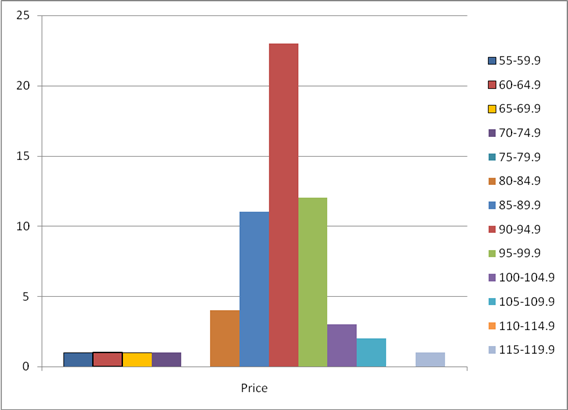
c.
To construct: A relative frequency distribution.
Explanation of Solution
Given information:The table of frequency distribution is given by
| Dormancy period | Frequency |
| 55-59.9 | 1 |
| 60-64.9 | 1 |
| 65-69.9 | 1 |
| 70-74.9 | 1 |
| 75-79.9 | 0 |
| 80-84.9 | 4 |
| 85-89.9 | 11 |
| 90-94.9 | 23 |
| 95-99.9 | 12 |
| 100-104.9 | 3 |
| 105-109.9 | 2 |
| 110-114.9 | 0 |
| 115-119.9 | 1 |
Formula used:
Solution:
From the given table,
The sum of all frequency is
The table of relative frequency is given by
| Dormancy period | Frequency | Relative frequency |
| 55-59.9 | 1 | |
| 60-64.9 | 1 | |
| 65-69.9 | 1 | |
| 70-74.9 | 1 | |
| 75-79.9 | 0 | |
| 80-84.9 | 4 | |
| 85-89.9 | 11 | |
| 90-94.9 | 23 | |
| 95-99.9 | 12 | |
| 100-104.9 | 3 | |
| 105-109.9 | 2 | |
| 110-114.9 | 0 | |
| 115-119.9 | 1 |
d.
To construct: A relative frequency histogram.
Explanation of Solution
Given information:The following table presents the durations, in minutes, of 60 dormancy periods that occurred during a recent year.
| 91 | 99 | 99 | 83 | 99 | 85 | 90 | 96 | 88 | 93 |
| 88 | 88 | 92 | 116 | 59 | 101 | 90 | 71 | 103 | 97 |
| 82 | 91 | 89 | 89 | 94 | 94 | 61 | 96 | 66 | 105 |
| 90 | 93 | 88 | 92 | 86 | 93 | 95 | 83 | 90 | 99 |
| 89 | 94 | 90 | 95 | 93 | 105 | 96 | 92 | 101 | 91 |
| 94 | 92 | 94 | 86 | 88 | 99 | 90 | 99 | 84 | 92 |
Definition used: Histograms based on relative frequency distributions are called relative frequency histogram.
Solution:
| Dormancy period | Relative frequency |
| 55-59.9 | 0.017 |
| 60-64.9 | 0.017 |
| 65-69.9 | 0.017 |
| 70-74.9 | 0.017 |
| 75-79.9 | 0.000 |
| 80-84.9 | 0.067 |
| 85-89.9 | 0.183 |
| 90-94.9 | 0.383 |
| 95-99.9 | 0.200 |
| 100-104.9 | 0.050 |
| 105-109.9 | 0.033 |
| 110-114.9 | 0.000 |
| 115-119.9 | 0.017 |
Therelative frequency histogram for the given data is given by
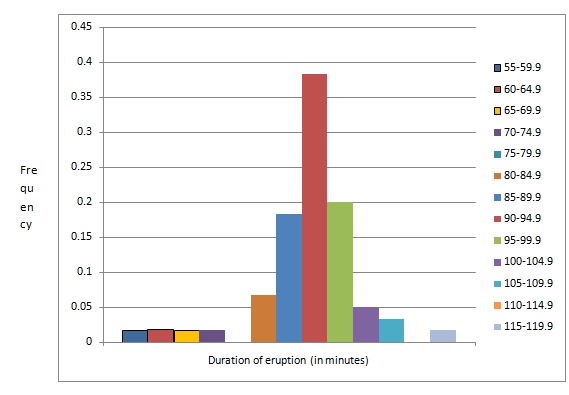
e.
To find: Whether the histograms are skewed to the right, skewed to the left , or approximately symmetric.
Answer to Problem 32E
The histogram is skewed to the left.
Explanation of Solution
Given information:The following table presents the durations, in minutes, of 60 dormancy periods that occurred during a recent year.
| 91 | 99 | 99 | 83 | 99 | 85 | 90 | 96 | 88 | 93 |
| 88 | 88 | 92 | 116 | 59 | 101 | 90 | 71 | 103 | 97 |
| 82 | 91 | 89 | 89 | 94 | 94 | 61 | 96 | 66 | 105 |
| 90 | 93 | 88 | 92 | 86 | 93 | 95 | 83 | 90 | 99 |
| 89 | 94 | 90 | 95 | 93 | 105 | 96 | 92 | 101 | 91 |
| 94 | 92 | 94 | 86 | 88 | 99 | 90 | 99 | 84 | 92 |
Definition used:
A histogram which has a long right-hand tail is said to be skewed to the right.
A histogram which has a long left-hand tail is said to be skewed to the left.
A histogram is symmetric if its right half is a minor image of its left half.
Solution:
The frequency histogram for the given data is given by
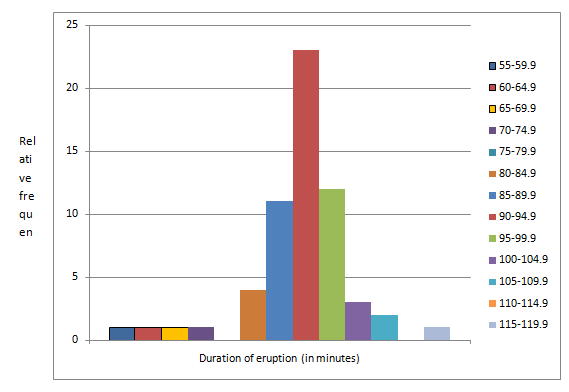
The above histogram has a long left-hand tail; therefore, it is skewed to the left.
Hence, the histogram is skewed to the left.
f.
To construct: A frequency distribution using a class width of 10, and using 50 as the lower class limit for the first class, a frequency histogram, relative frequency distribution and relative frequency histogram.
Explanation of Solution
Given information: The following table presents the durations, in minutes, of 60 dormancy periods that occurred during a recent year.
| 91 | 99 | 99 | 83 | 99 | 85 | 90 | 96 | 88 | 93 |
| 88 | 88 | 92 | 116 | 59 | 101 | 90 | 71 | 103 | 97 |
| 82 | 91 | 89 | 89 | 94 | 94 | 61 | 96 | 66 | 105 |
| 90 | 93 | 88 | 92 | 86 | 93 | 95 | 83 | 90 | 99 |
| 89 | 94 | 90 | 95 | 93 | 105 | 96 | 92 | 101 | 91 |
| 94 | 92 | 94 | 86 | 88 | 99 | 90 | 99 | 84 | 92 |
Solution:
The class width is 10. The minimum and maximum values of the ratings are 50 and 119.9.
The table of frequency distribution is given by
| Dormancy period | Frequency |
| 50-59.9 | 1 |
| 60-69.9 | 2 |
| 70-79.9 | 1 |
| 80-89.9 | 15 |
| 90-99.9 | 35 |
| 100-109.9 | 5 |
| 110-119.9 | 1 |
The frequency histogram for the given data is given by
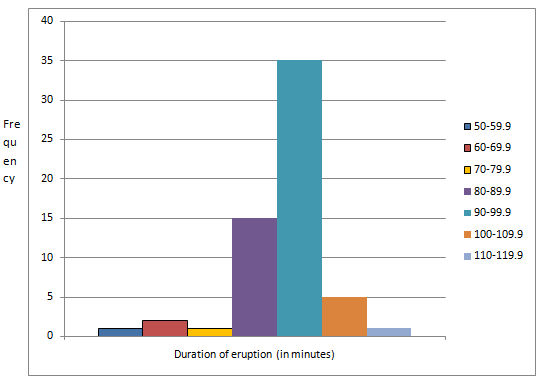
The sum of all frequency is
The relative frequency distribution table is given by
| Dormancy period | Frequency | Relative frequency |
| 50-59.9 | 1 | |
| 60-69.9 | 2 | |
| 70-79.9 | 1 | |
| 80-89.9 | 15 | |
| 90-99.9 | 35 | |
| 100-109.9 | 5 | |
| 110-119.9 | 1 |
The relative frequency histogram for the given data is given by
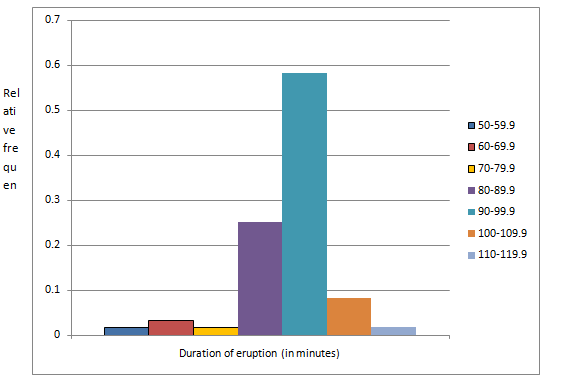
g.
To explain: Whether the good choices for the data are that class width of 5 or 10.
Answer to Problem 32E
Explanation of Solution
Given information:The following table presents the durations, in minutes, of 60 dormancy periods that occurred during a recent year.
| 91 | 99 | 99 | 83 | 99 | 85 | 90 | 96 | 88 | 93 |
| 88 | 88 | 92 | 116 | 59 | 101 | 90 | 71 | 103 | 97 |
| 82 | 91 | 89 | 89 | 94 | 94 | 61 | 96 | 66 | 105 |
| 90 | 93 | 88 | 92 | 86 | 93 | 95 | 83 | 90 | 99 |
| 89 | 94 | 90 | 95 | 93 | 105 | 96 | 92 | 101 | 91 |
| 94 | 92 | 94 | 86 | 88 | 99 | 90 | 99 | 84 | 92 |
The class width of 5 provides more appropriate level of detail in the middle of the histogram, but it is very sparse in the tail.
The class width of 10 is better in the tails, but most of the data are in only two classes.
Therefore, the distribution of class width of 5 is more reasonably good choice than class width of 10.
Want to see more full solutions like this?
Chapter 2 Solutions
ELEMENTARY STATISTICS-ALEKS ACCESS CODE
- Faye cuts the sandwich in two fair shares to her. What is the first half s1arrow_forwardQuestion 2. An American option on a stock has payoff given by F = f(St) when it is exercised at time t. We know that the function f is convex. A person claims that because of convexity, it is optimal to exercise at expiration T. Do you agree with them?arrow_forwardQuestion 4. We consider a CRR model with So == 5 and up and down factors u = 1.03 and d = 0.96. We consider the interest rate r = 4% (over one period). Is this a suitable CRR model? (Explain your answer.)arrow_forward
- Question 3. We want to price a put option with strike price K and expiration T. Two financial advisors estimate the parameters with two different statistical methods: they obtain the same return rate μ, the same volatility σ, but the first advisor has interest r₁ and the second advisor has interest rate r2 (r1>r2). They both use a CRR model with the same number of periods to price the option. Which advisor will get the larger price? (Explain your answer.)arrow_forwardQuestion 5. We consider a put option with strike price K and expiration T. This option is priced using a 1-period CRR model. We consider r > 0, and σ > 0 very large. What is the approximate price of the option? In other words, what is the limit of the price of the option as σ∞. (Briefly justify your answer.)arrow_forwardQuestion 6. You collect daily data for the stock of a company Z over the past 4 months (i.e. 80 days) and calculate the log-returns (yk)/(-1. You want to build a CRR model for the evolution of the stock. The expected value and standard deviation of the log-returns are y = 0.06 and Sy 0.1. The money market interest rate is r = 0.04. Determine the risk-neutral probability of the model.arrow_forward
- Several markets (Japan, Switzerland) introduced negative interest rates on their money market. In this problem, we will consider an annual interest rate r < 0. We consider a stock modeled by an N-period CRR model where each period is 1 year (At = 1) and the up and down factors are u and d. (a) We consider an American put option with strike price K and expiration T. Prove that if <0, the optimal strategy is to wait until expiration T to exercise.arrow_forwardWe consider an N-period CRR model where each period is 1 year (At = 1), the up factor is u = 0.1, the down factor is d = e−0.3 and r = 0. We remind you that in the CRR model, the stock price at time tn is modeled (under P) by Sta = So exp (μtn + σ√AtZn), where (Zn) is a simple symmetric random walk. (a) Find the parameters μ and σ for the CRR model described above. (b) Find P Ste So 55/50 € > 1). StN (c) Find lim P 804-N (d) Determine q. (You can use e- 1 x.) Ste (e) Find Q So (f) Find lim Q 004-N StN Soarrow_forwardIn this problem, we consider a 3-period stock market model with evolution given in Fig. 1 below. Each period corresponds to one year. The interest rate is r = 0%. 16 22 28 12 16 12 8 4 2 time Figure 1: Stock evolution for Problem 1. (a) A colleague notices that in the model above, a movement up-down leads to the same value as a movement down-up. He concludes that the model is a CRR model. Is your colleague correct? (Explain your answer.) (b) We consider a European put with strike price K = 10 and expiration T = 3 years. Find the price of this option at time 0. Provide the replicating portfolio for the first period. (c) In addition to the call above, we also consider a European call with strike price K = 10 and expiration T = 3 years. Which one has the highest price? (It is not necessary to provide the price of the call.) (d) We now assume a yearly interest rate r = 25%. We consider a Bermudan put option with strike price K = 10. It works like a standard put, but you can exercise it…arrow_forward
- In this problem, we consider a 2-period stock market model with evolution given in Fig. 1 below. Each period corresponds to one year (At = 1). The yearly interest rate is r = 1/3 = 33%. This model is a CRR model. 25 15 9 10 6 4 time Figure 1: Stock evolution for Problem 1. (a) Find the values of up and down factors u and d, and the risk-neutral probability q. (b) We consider a European put with strike price K the price of this option at time 0. == 16 and expiration T = 2 years. Find (c) Provide the number of shares of stock that the replicating portfolio contains at each pos- sible position. (d) You find this option available on the market for $2. What do you do? (Short answer.) (e) We consider an American put with strike price K = 16 and expiration T = 2 years. Find the price of this option at time 0 and describe the optimal exercising strategy. (f) We consider an American call with strike price K ○ = 16 and expiration T = 2 years. Find the price of this option at time 0 and describe…arrow_forward2.2, 13.2-13.3) question: 5 point(s) possible ubmit test The accompanying table contains the data for the amounts (in oz) in cans of a certain soda. The cans are labeled to indicate that the contents are 20 oz of soda. Use the sign test and 0.05 significance level to test the claim that cans of this soda are filled so that the median amount is 20 oz. If the median is not 20 oz, are consumers being cheated? Click the icon to view the data. What are the null and alternative hypotheses? OA. Ho: Medi More Info H₁: Medi OC. Ho: Medi H₁: Medi Volume (in ounces) 20.3 20.1 20.4 Find the test stat 20.1 20.5 20.1 20.1 19.9 20.1 Test statistic = 20.2 20.3 20.3 20.1 20.4 20.5 Find the P-value 19.7 20.2 20.4 20.1 20.2 20.2 P-value= (R 19.9 20.1 20.5 20.4 20.1 20.4 Determine the p 20.1 20.3 20.4 20.2 20.3 20.4 Since the P-valu 19.9 20.2 19.9 Print Done 20 oz 20 oz 20 oz 20 oz ce that the consumers are being cheated.arrow_forwardT Teenage obesity (O), and weekly fast-food meals (F), among some selected Mississippi teenagers are: Name Obesity (lbs) # of Fast-foods per week Josh 185 10 Karl 172 8 Terry 168 9 Kamie Andy 204 154 12 6 (a) Compute the variance of Obesity, s²o, and the variance of fast-food meals, s², of this data. [Must show full work]. (b) Compute the Correlation Coefficient between O and F. [Must show full work]. (c) Find the Coefficient of Determination between O and F. [Must show full work]. (d) Obtain the Regression equation of this data. [Must show full work]. (e) Interpret your answers in (b), (c), and (d). (Full explanations required). Edit View Insert Format Tools Tablearrow_forward
 Glencoe Algebra 1, Student Edition, 9780079039897...AlgebraISBN:9780079039897Author:CarterPublisher:McGraw Hill
Glencoe Algebra 1, Student Edition, 9780079039897...AlgebraISBN:9780079039897Author:CarterPublisher:McGraw Hill Holt Mcdougal Larson Pre-algebra: Student Edition...AlgebraISBN:9780547587776Author:HOLT MCDOUGALPublisher:HOLT MCDOUGAL
Holt Mcdougal Larson Pre-algebra: Student Edition...AlgebraISBN:9780547587776Author:HOLT MCDOUGALPublisher:HOLT MCDOUGAL Big Ideas Math A Bridge To Success Algebra 1: Stu...AlgebraISBN:9781680331141Author:HOUGHTON MIFFLIN HARCOURTPublisher:Houghton Mifflin Harcourt
Big Ideas Math A Bridge To Success Algebra 1: Stu...AlgebraISBN:9781680331141Author:HOUGHTON MIFFLIN HARCOURTPublisher:Houghton Mifflin Harcourt Trigonometry (MindTap Course List)TrigonometryISBN:9781305652224Author:Charles P. McKeague, Mark D. TurnerPublisher:Cengage Learning
Trigonometry (MindTap Course List)TrigonometryISBN:9781305652224Author:Charles P. McKeague, Mark D. TurnerPublisher:Cengage Learning



